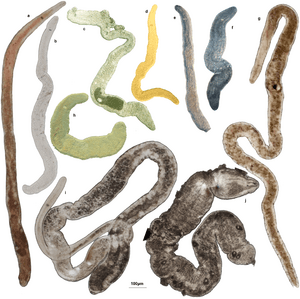Nemertodermatida facts for kids
Quick facts for kids Nemertodermatida |
|
|---|---|
 |
|
| Scientific classification |
|
| Kingdom: | Animalia |
| Phylum: | Xenacoelomorpha |
| Subphylum: | Acoelomorpha |
| Class: | Nemertodermatida Karling, 1940 |
Nemertodermatida are a special group of tiny, worm-like animals. They are so small that most are only about a millimeter long, which is roughly the size of a pencil tip! These creatures are part of a larger group called Acoelomorpha. Scientists have discovered 18 different kinds of Nemertodermatida so far. They mostly live in the spaces between sand grains or mud particles in the ocean.
Contents
What are Nemertodermatida?
Nemertodermatida are simple animals that look a bit like flatworms. They don't have a true brain or a complex digestive system like many other animals. Instead, they have a very basic body plan. They are often described as "turbellariform," which means they have a flattened, leaf-like or ribbon-like shape, similar to some types of flatworms.
Where do they live?
These tiny worms are mostly found in marine environments. This means they live in the ocean. They prefer to live in the "interstitial" spaces. This term refers to the tiny gaps and spaces found between sand grains, mud, or other sediments on the seafloor. They are often found in shallow waters, but some might live deeper. Their small size allows them to move easily through these tight spaces.
What do they look like?
Nemertodermatida are usually colorless or have a very pale, translucent body. This makes them hard to spot in their natural habitat. They have a soft body without any hard shell or skeleton. They don't have eyes that can see images, but they might have simple light-sensing spots. Their bodies are covered in tiny hairs called cilia. These cilia help them move around and find food.
How do they eat and move?
Since they are so small and live in tight spaces, Nemertodermatida have unique ways of eating and moving.
- Movement: They use the tiny cilia on their bodies to glide through the water and between sand grains. It's like they are swimming or sliding along surfaces.
- Diet: Scientists believe they feed on very small particles. This could include tiny bits of decaying organic matter or even microscopic organisms like bacteria and diatoms that live in the sediment. They absorb nutrients directly through their simple gut.
How do they reproduce?
Like many simple invertebrates, Nemertodermatida can reproduce in different ways. They are often hermaphrodites, meaning each individual has both male and female reproductive parts. This allows them to potentially reproduce with any other individual they encounter. They lay eggs, which then develop into new worms. The exact details of their life cycle are still being studied by scientists.
Their place in the animal kingdom
Nemertodermatida belong to the phylum Acoelomorpha. This group is very interesting to scientists because it helps us understand the early evolution of animals. Acoelomorphs are thought to be some of the most ancient and simple bilateral animals. Bilateral means their bodies have a left and right side that are mirror images of each other. Studying Nemertodermatida helps us learn more about how complex animal bodies developed over millions of years.
See also
 In Spanish: Nemertodermátidos para niños
In Spanish: Nemertodermátidos para niños

